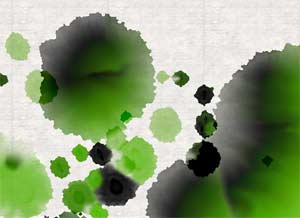Many people have a habit of thoroughly cleaning the nib of their pen when switching to a new type of ink before drawing in the new ink.
This is done because they understand that mixing two different types of ink often leads to precipitation.
 Normal blue ink is typically made from a combination of iron sulfate and a blue dye to create a dilute solution. In that solution, there are usually colloidal substances with small particles that carry electrical charges. Since the ink is of the same type, the electrical charges of those colloidal particles are identical. The property is that similar charges repel each other while different charges attract. The small particles will push each other away, preventing them from aggregating into larger particles.
Normal blue ink is typically made from a combination of iron sulfate and a blue dye to create a dilute solution. In that solution, there are usually colloidal substances with small particles that carry electrical charges. Since the ink is of the same type, the electrical charges of those colloidal particles are identical. The property is that similar charges repel each other while different charges attract. The small particles will push each other away, preventing them from aggregating into larger particles.
When we mix two different types of ink, if they are made from the same ingredients, nothing happens. However, if different ingredients are used, the differing electrical charges will cause the small particles in the ink to attract each other; as a result, the particles will grow larger, and eventually, sediment will form at the bottom of the ink bottle. For example, pure blue ink made from acidic dye will quickly precipitate into large clumps if it encounters a basic dye. This not only clogs the pen nib but also degrades the color of the ink. The ink that was once blue may turn very pale and appear diluted.
Understanding these reasons, you will realize that a pen cannot use two different brands of ink interchangeably. If your ink runs out and you want to switch to another ink, you must thoroughly clean the nib of the pen before drawing in the new ink to avoid chemical precipitation that can affect the pen’s lifespan.

















































